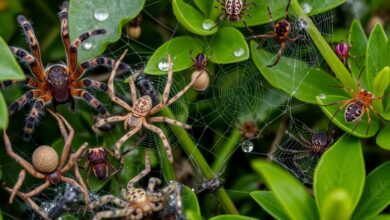Huntsman Spider: All About These Large Arachnids

Get ready to explore the world of huntsman spiders. These large, fascinating arachnids are also called “giant crab spiders.” They have broad, flat bodies and long legs. You can find them in warm places like the United States, Australia, and parts of Asia.
Huntsman spiders are known for their speed. They can move quickly across surfaces and even climb up walls. Watching them is truly captivating.
These spiders are important in their ecosystems. They mostly eat insects and small invertebrates. With over 50,000 spider species worldwide, huntsman spiders are unique and interesting. They have many behaviors and adaptations. Let’s discover the wonders of these fast-moving spiders!
Embrace the Fascinating World of Huntsman Spiders
Get ready to dive into the world of huntsman spiders. These arachnids have fascinated scientists and the public for a long time. They are known for their large size and fast movements.
Uncovering the Mysteries of These Unique Arachnids
Huntsman spiders have broad bodies and long legs. They are fast and agile, making them stand out. Their speed is so impressive that they seem to run rather than crawl.
These spiders are big and striking, making a strong impression. They are perfect for anyone interested in spiders or the natural world. Huntsman spiders are sure to spark your curiosity and make you appreciate spiders more.
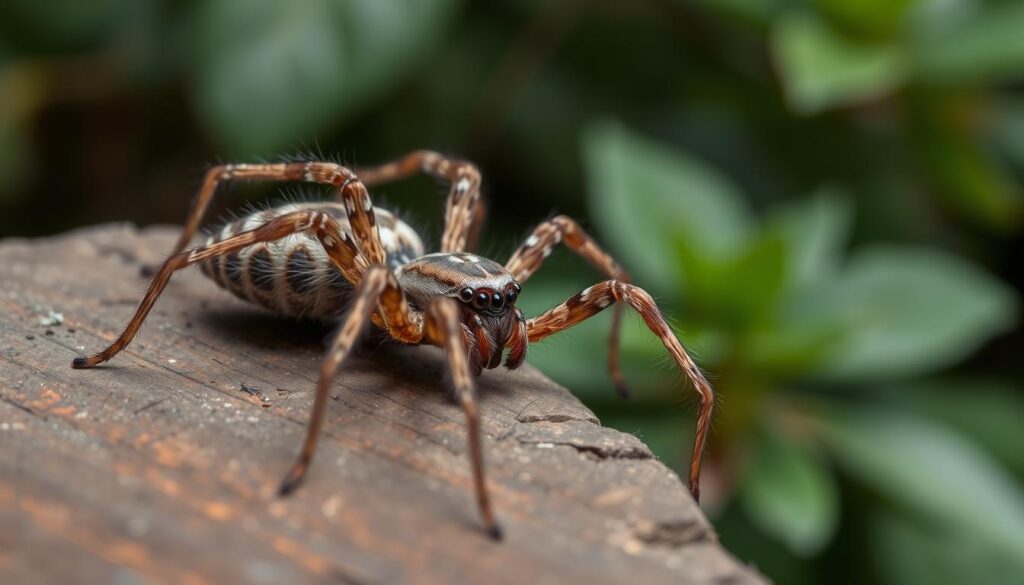
Exploring huntsman spiders reveals their amazing adaptations and behaviors. They play a key role in keeping ecosystems balanced. Let’s uncover the secrets of these incredible chelicerata arachnid creatures together.
The Huntsman Spider Family: A Diverse Group
The huntsman spider family, known as Sparassidae, is fascinating and diverse. They have over 1,100 species in warm areas worldwide. Their broad bodies and long legs help them move fast and efficiently.
From the giant crab huntsman to the wood huntsman, they show amazing adaptations. These traits help them survive in different environments.
These spiders vary greatly in size, color, and behavior. Their diversity makes them interesting to study and watch. Some are super fast, while others can hide well in their surroundings.
Huntsman spiders can move quickly, catching their prey by surprise. Their strong jaws and venom make them good hunters. They can eat insects and small animals.
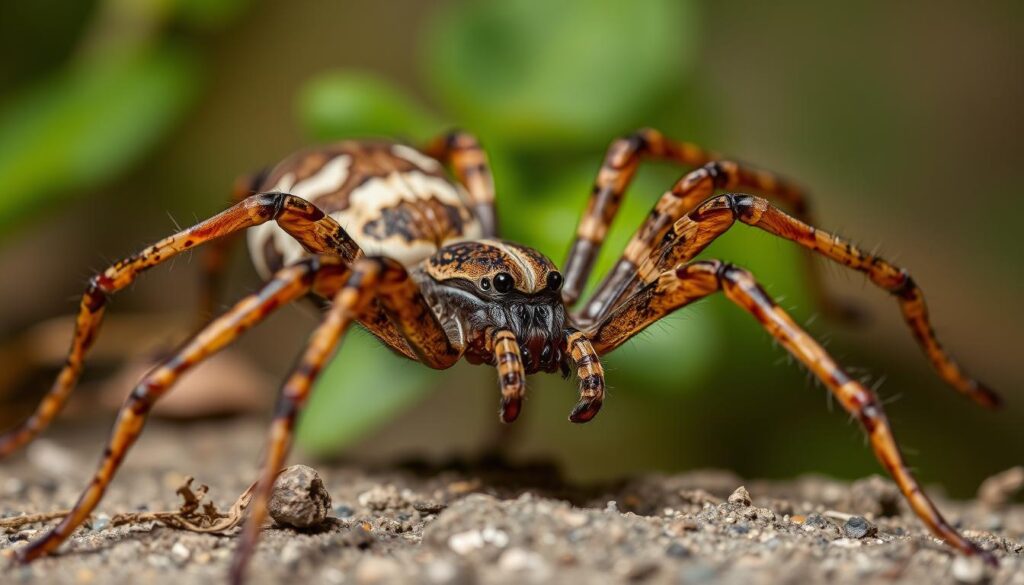
Even though they look scary, most huntsman spiders are not dangerous to humans. Many are calm and try to stay away. But, it’s wise to be careful around them. Their bites can hurt and might cause mild reactions in some people.
Exploring the huntsman spider family reveals a true marvel of nature. They are a diverse group of spiders that have adapted to many habitats. Their resilience and adaptability are truly impressive.
Identifying Characteristics: What Makes a Huntsman Spider?
Huntsman spiders are known for their unique looks. They have broad, flat bodies and long legs that can reach up to 12 inches wide. Their legs are usually brown or gray and may have special patterns.
One key feature of the huntsman spider is their big, forward-facing eyes. These eyes help them see prey and dangers from far away. They are also fast and agile, making them great hunters.
Unraveling the Distinctive Features of These Large Spiders
The huntsman spider is a natural wonder. It has many features that make it stand out. Some of these include:
- Broad, flat bodies for easy movement in tight spaces
- Long, spindly legs that can span up to 12 inches in diameter
- Brown or gray leg coloration with distinctive markings or patterns
- Large, forward-facing eyes that provide excellent vision and hunting prowess
- Remarkable speed and agility, allowing them to chase down and capture prey
These features help the huntsman spider be easily spotted. They also make them great hunters and help them adapt to their surroundings.
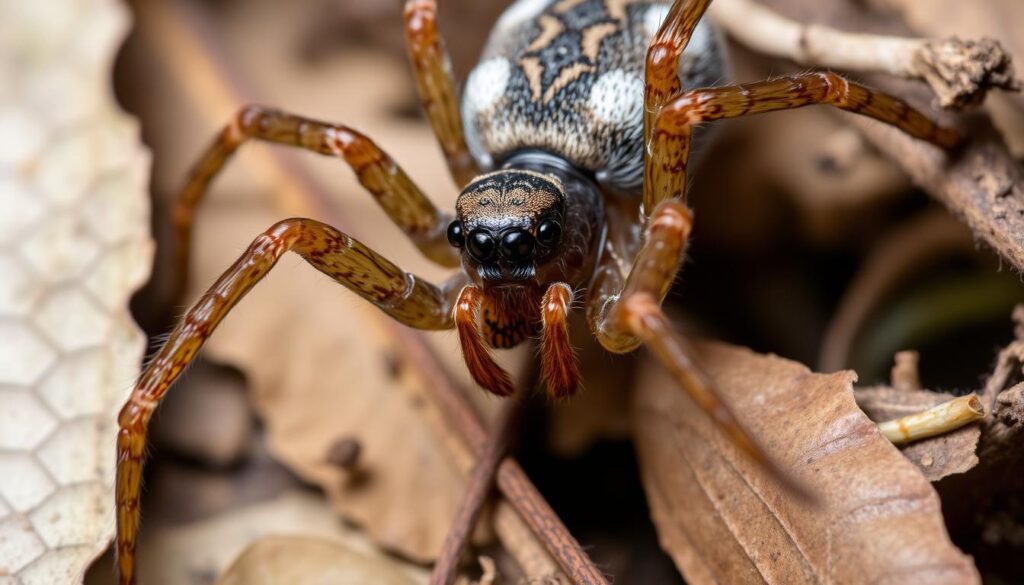
Habitat and Distribution: Where Do Huntsman Spiders Thrive?
The huntsman spider is found in warm places like the southern United States, Australia, Asia, and parts of Africa. They live in many places, from tropical forests and woodlands to cities and homes.
These spiders are great climbers. Their flat bodies and long legs help them move easily in different places. They like to hide in small spaces, like under bark or in building eaves.
The distribution of huntsman spiders shows how well they can adapt to different habitats. You might see them in a rainforest or a city. Each spider has its own story.
| Habitat | Habitat Characteristics | Huntsman Spider Adaptations |
|---|---|---|
| Tropical Forests | Dense vegetation, high humidity, and diverse prey | Camouflage, fast movement, and ability to navigate complex environments |
| Urban Areas | Buildings, crevices, and access to food sources like insects | Climbing skills, adaptability to human environments, and opportunistic feeding habits |
| Woodlands | Mixed vegetation, ample hiding spots, and diverse prey | Flat body shape, keen senses, and swift reflexes to navigate and hunt in this habitat |
The huntsman spiders have amazed people all over the world. Their wide distribution and ability to live in many habitats make them even more fascinating. Seeing them in the wild or in your backyard is a reminder of nature’s wonders.
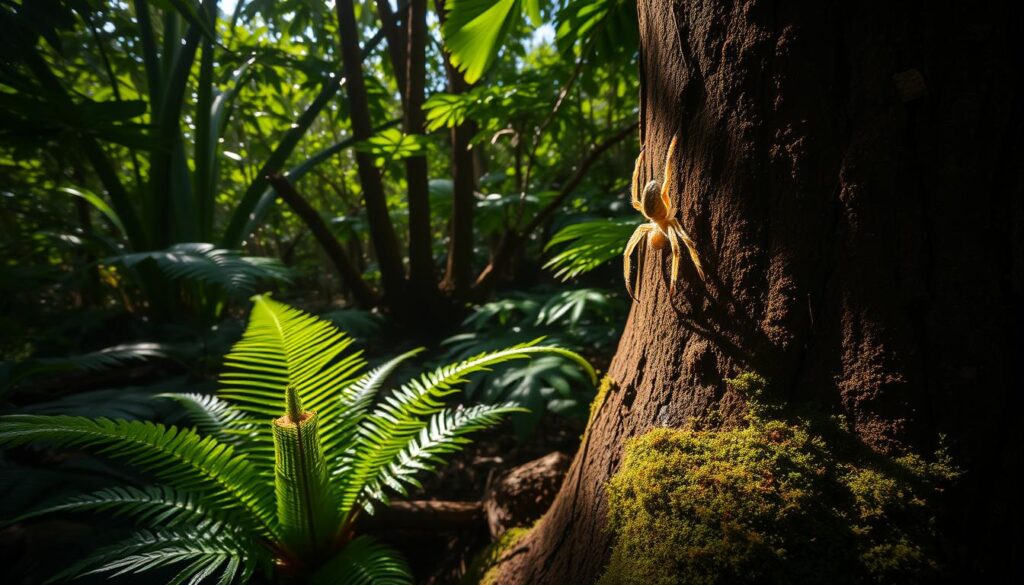
The Huntsman Spider Diet: Exploring Their Predatory Habits
Huntsman spiders are known for their size and unique looks. They are mostly meat-eaters. They hunt small insects, other spiders, and even tiny lizards or frogs.
These spiders hunt in a special way. They wait for their prey and then quickly catch it. After catching it, they break it down with special enzymes and eat it.
| Prey Type | Hunting Behavior |
|---|---|
| Insects | Huntsman spiders are skilled at chasing down and capturing insects such as flies, mosquitoes, and beetles. They use their long legs and lightning-fast reflexes to pounce on their prey. |
| Spiders | These large arachnids are known to prey on other spider species, including smaller huntsman spiders and web-building spiders. |
| Small Vertebrates | Huntsman spiders have been observed preying on small lizards, frogs, and even small birds. Their powerful fangs and liquefying enzymes allow them to subdue these larger prey. |
The huntsman spider’s diet shows their amazing hunting skills. They play a key role in keeping the ecosystem balanced. They help control the numbers of smaller animals and insects.
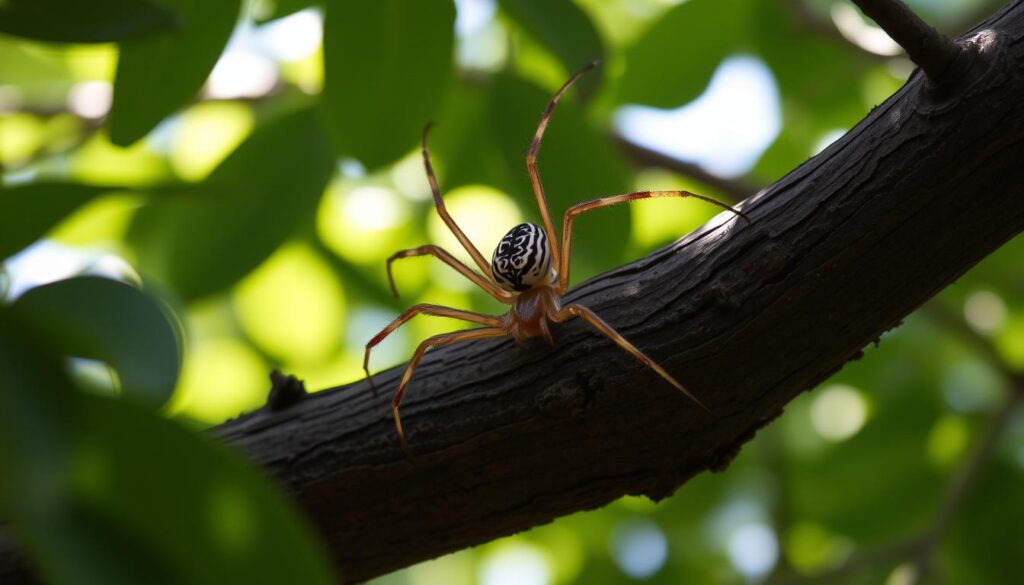
Huntsman Spiders and Humans: Addressing Common Concerns
Debunking Myths and Understanding Their Behavior
Huntsman spiders may look big and scary, but they’re not a big deal for humans. They are not usually aggressive and only bite when they feel threatened or are handled roughly. Their venom is not harmful to humans, and their bites usually cause only mild reactions.
But, there are many myths and misconceptions about these spiders. By learning the truth about them, you can see how amazing they are without fear.
It’s not true that huntsman spiders are deadly or a big health risk. Only a few spider species in the U.S., like the black widow and brown recluse, are dangerous. Huntsman spider venom is mild and won’t hurt humans.
These spiders are mostly focused on finding food and surviving. They don’t want to bother humans. They will only bite if they feel threatened or are handled carelessly.
Also, huntsman spiders are not aggressive and don’t chase humans. They often live in homes, helping to control other pests. Knowing how safe they are can help you feel better about them.
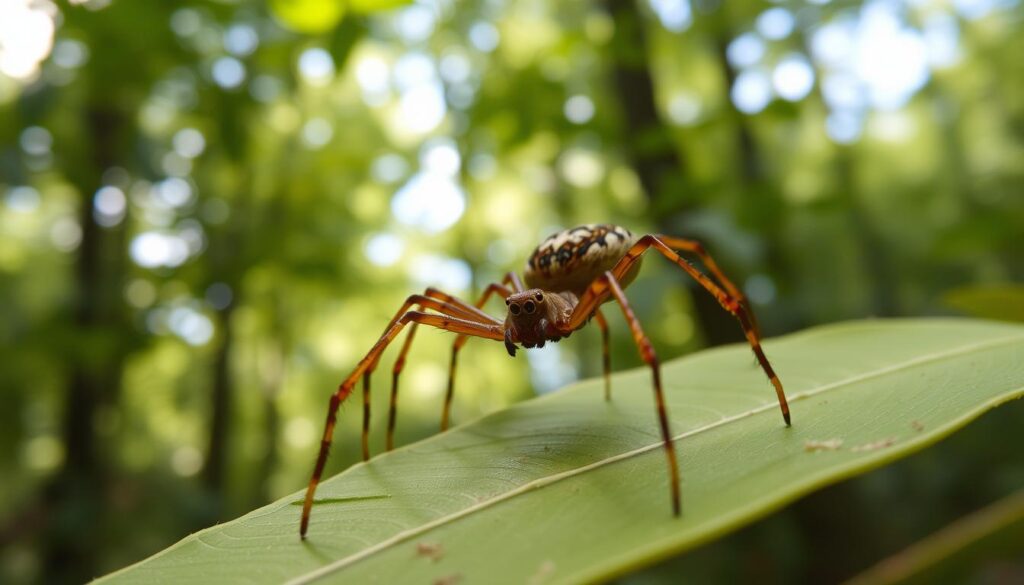
Reproduction and Life Cycle: A Closer Look
The world of the huntsman spider is full of wonder. These spiders have a complex life cycle with different stages and unique mating rituals. From hatching to adulthood, their reproductive behaviors are fascinating.
Female huntsman spiders lay eggs in safe places like under bark. The eggs hatch into spiderlings that grow and molt several times. This growth is crucial for their development and future reproduction.
The mating rituals of huntsman spiders are quite interesting. They perform complex courtship dances and even make sounds. The sperm transfer from male to female is key for fertilizing eggs and continuing the species.
| Characteristic | Huntsman Spider | Goliath Birdeater |
|---|---|---|
| Body Weight | Varies by species | 170 grams (6 ounces) |
| Body Length | Varies by species | 13 centimeters (5 inches) |
| Leg Span | Varies by species | 30 centimeters (12 inches) |
| Lifespan (Females) | Varies by species | 10 to 15 years, up to 25 years |
| Eggs per Sac | Varies by species | 100 to 200 |
| Time to Maturity | Varies by species | 2 to 3 years |
The life cycle of the huntsman spider shows their amazing adaptations. Their unique mating behaviors and growth make them fascinating to study.
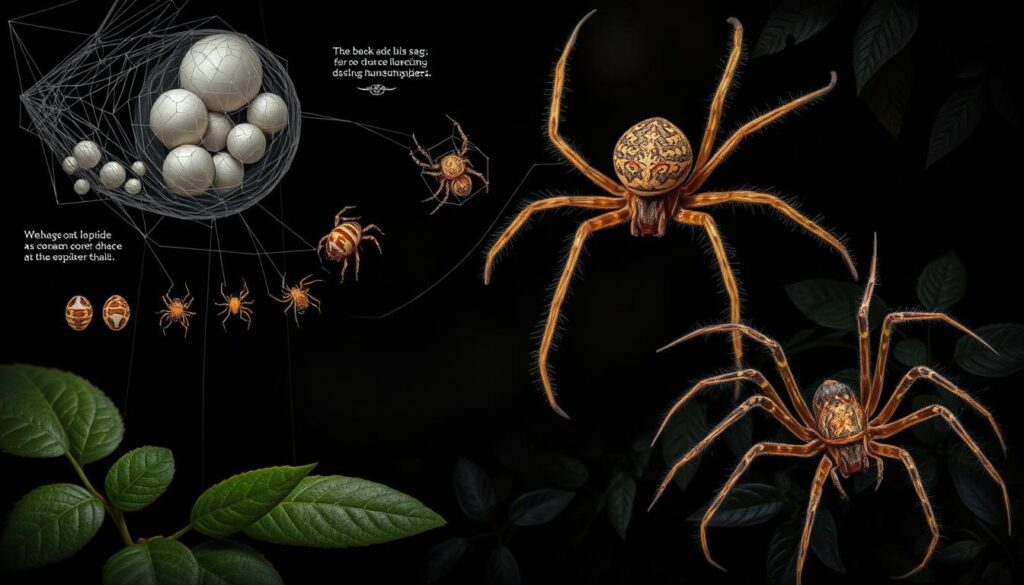
Huntsman Spider in Popular Culture and Folklore
The huntsman spider has caught the eye of people worldwide. Its unique look and abilities have made it a favorite in stories, movies, and games. It’s also a part of folklore.
In some places, these spiders are seen as symbols of strength and speed. They are known for their agility and ability to climb and jump. This has led to their appearance in many stories, where they are often shown in a positive light.
But in other cultures, they are seen as bad luck or even supernatural. Their sudden appearances have sparked many legends. This adds mystery and superstition to their image.
Huntsman spiders have made a big impact on culture. Their large size and unique legs make them easy to spot. Their lasting appeal shows how much people are drawn to them.
| Representation in Popular Culture | Examples |
|---|---|
| Literature |
|
| Film and Television |
|
| Video Games |
|
| Folklore and Mythology |
|
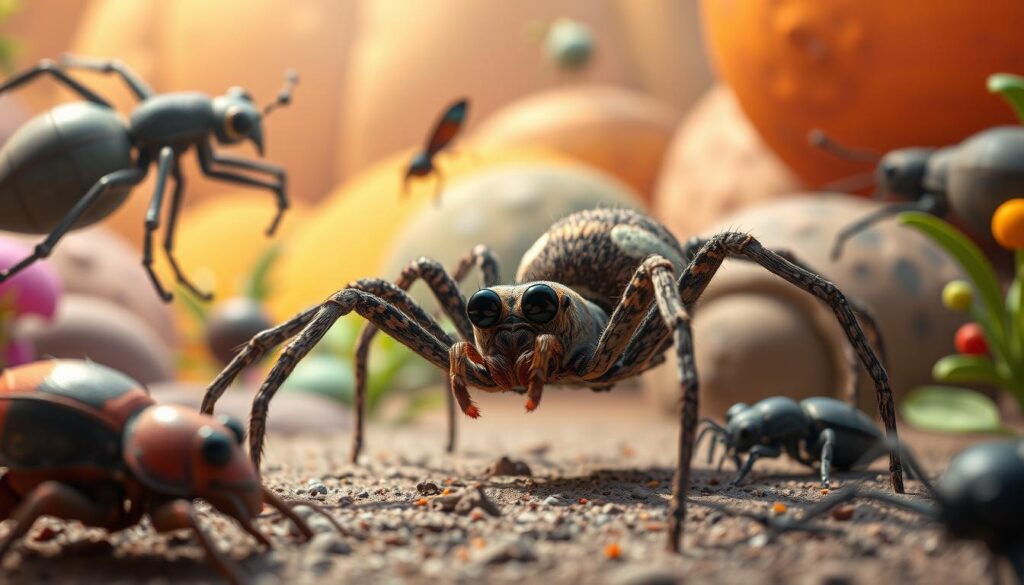
The huntsman spider’s lasting impact on culture and folklore shows its captivating nature. It has a special place in the human imagination.
Intriguing Huntsman Spider Species: A Closer Examination
Uncovering the Diversity Within This Fascinating Group
The huntsman spider family, known as Sparassidae, is full of diverse species. Each has its own special traits and ways to adapt. From the huge, crab-like giant crab huntsman to the smaller wood huntsman, they show the wide range in the Sparassidae family.
Some, like the domestic huntsman, live near humans. Others, found in tropical forests, have special ways to hunt. Learning about these spiders’ unique features and behaviors is fascinating. It shows how they’ve adapted to different places around the world.
The Bronze Huntsman spider is big, with females up to 15 centimeters long. They hunt at night, using their strong legs and quick speed. Their bites are usually not serious, causing only minor swelling or irritation.
The wood huntsman is great at hiding in tree bark. It has a flat body and long legs, perfect for sneaking into tight spots. This spider is very good at hunting quietly.
Looking at all the huntsman spider species, we see many cool adaptations and hunting ways. They live in many places, from cities to dense forests. Each species’ unique traits help us understand the amazing diversity in the huntsman spider family.
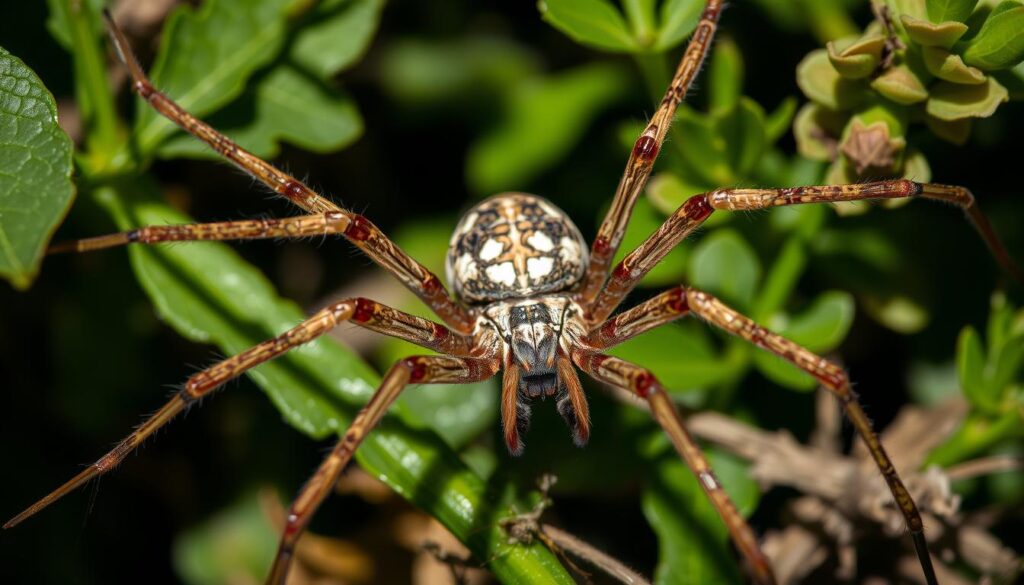
Conservation Efforts: Protecting Our Eight-Legged Friends
The huntsman spider is facing many threats. These include habitat loss, pesticide use, and climate change. But, there are efforts to save these amazing spiders.
Creating protected habitats is a key strategy. This lets huntsman spiders live without human disturbance. Practices like sustainable farming and smart city planning also help.
Education is another important part. Teaching people about huntsman spiders helps us all appreciate them. This can lead to more people helping protect them.
Together, we can save the huntsman spider for the future. This not only keeps our planet healthy but also celebrates its diversity.
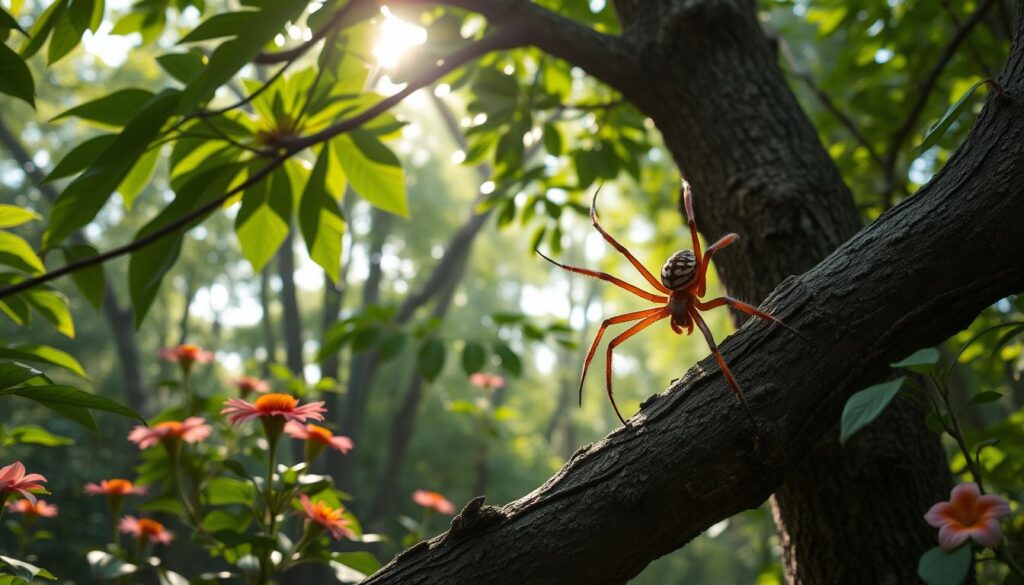
The Huntsman Spider: A Remarkable Arachnid
The huntsman spider is truly remarkable. It has a unique mix of traits that make it stand out. These spiders are big and flat, moving fast and agilely across walls and ceilings.
They come in many sizes and colors. The Banded Huntsman can have a leg span of up to 5 inches, making it one of the largest spiders. The Pink Huntsman is smaller, with females reaching about 2.5 centimeters in length.
Despite their size, huntsman spiders are not aggressive towards humans. They are generally calm and prefer to run away rather than fight. Their bites are usually harmless, and they help control insect populations.
| Species | Size | Habitat | Behavior |
|---|---|---|---|
| Banded Huntsman | Up to 5 inches in leg span | Australia (Queensland, New South Wales, Victoria) | Nocturnal, do not build webs, rely on speed and precision to catch prey |
| Pink Huntsman | Females up to 2.5 cm, males around 1.5 cm | Forests and gardens | Nocturnal, wander in search of prey and shelter, feed on insects |
The huntsman spider’s unique traits and behaviors have fascinated people worldwide. It is truly a remarkable arachnid.
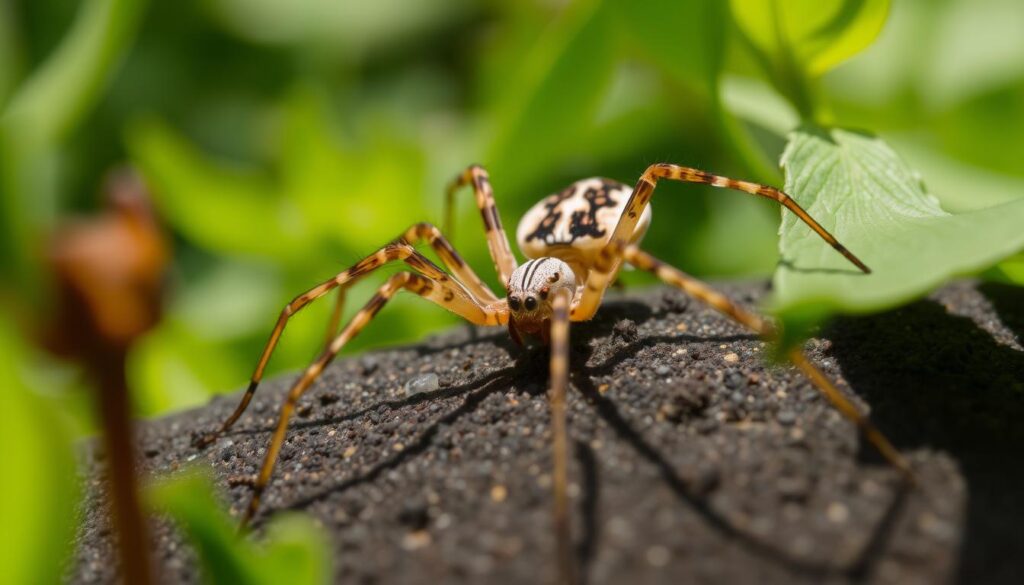
Huntsman Spider: Chelicerata Arachnid Extraordinaire
The huntsman spider is a fascinating creature in the Chelicerata subphylum. This group includes arachnids, horseshoe crabs, and more. The huntsman spider is known for its size, speed, and unique features that help it survive in many places.
These spiders are quite large. While most tarantulas are 2.5 to 10 centimeters long, the giant crab huntsman spider can grow even bigger. The largest one weighed up to 170 grams and had a leg span of 30 centimeters.
Huntsman spiders are also very fast and agile. They can move quickly across walls and ceilings. Their ability to flatten their bodies lets them fit into tight spaces, making them great at finding food in different environments.
These spiders have a special place in popular culture. They are often seen as symbols of good luck or even have supernatural powers in myths. Their size and speed make them popular in movies and books.
In summary, the huntsman spider is an amazing member of the Chelicerata family. Its size, speed, and adaptability make it a true marvel of nature.
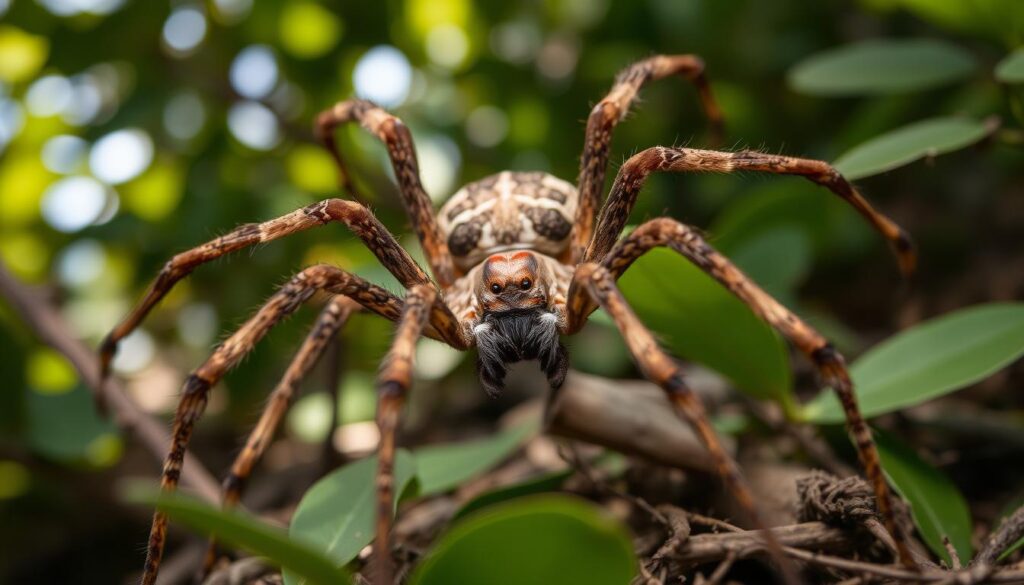
Unleashing the Secrets of the Domestic Huntsman Spider
Many huntsman spider species live in nature, but the domestic huntsman has learned to live with humans. They are often seen in homes, sheds, and buildings. They like to hide in small spaces, under furniture, or in the eaves.
Domestic huntsman spiders are not dangerous to humans. In fact, they help by eating insects and pests that might bother us. By understanding them, we can see their value in keeping our homes balanced.
Unraveling the Mysteries of These Household Guests
Domestic huntsman spiders are interesting members of the huntsman spider family. They are big, flat, and move fast. They can run sideways and upside down easily. Their long legs and broad bodies might look scary, but they are safe around people.
These spiders are great at living in human spaces. They find hidden spots in homes to wait for prey. They are also good at staying still, making them hard to spot.
- Domestic huntsman spiders are known for their lightning-fast movements and ability to run sideways and upside down.
- These spiders are skilled at finding hiding spots in and around homes, where they can ambush their prey.
- Domestic huntsman spiders are generally harmless to humans and can actually be beneficial, as they prey on insects and other pests.
By learning about domestic huntsman spiders, we can live in peace with them. They show how nature can adapt and survive. Their presence in our homes reminds us of the balance we share with nature.
| Characteristic | Description |
|---|---|
| Size | Domestic huntsman spiders can grow quite large, with leg spans of up to 12 inches (30 cm). |
| Appearance | These spiders have flat, broad bodies and long, spindly legs that allow them to move quickly and run sideways or upside down with ease. |
| Habitat | Domestic huntsman spiders are often found in crevices, under furniture, or in the eaves of buildings, where they can hide and ambush their prey. |
| Prey | Domestic huntsman spiders prey on insects, small lizards, and other pests that may invade human dwellings. |
| Threat to Humans | Despite their large size and intimidating appearance, domestic huntsman spiders are generally harmless to humans and pose no real threat. |
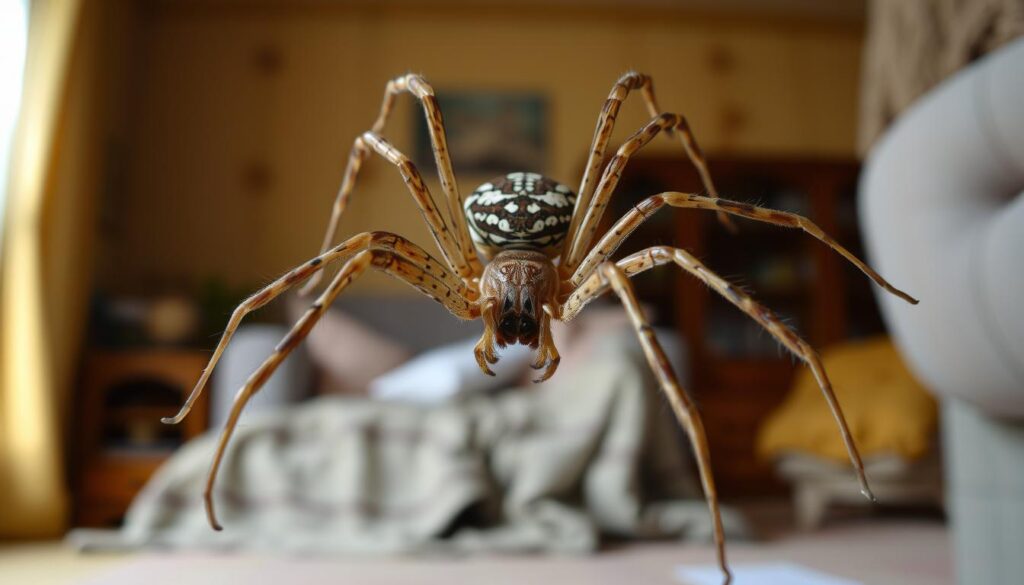
Fascinating Facts About the Giant Crab Huntsman Spider
The giant crab huntsman spider, also known as the giant crab spider, is a standout in the Sparassidae family. These huge arachnids can have a leg span of up to 12 inches. This makes them one of the largest spiders globally.
Despite their large size, these spiders are not harmful to humans and are generally calm. They use their broad, flat bodies and long legs to catch prey in a unique way.
Here are some fascinating facts about these remarkable creatures:
- The giant crab huntsman spider can have a leg span of up to 12 inches, making it one of the largest spiders in the world.
- These spiders are known for their ability to quickly move sideways, earning them the nickname “crab spider”“.
- Giant crab huntsman spiders are skilled ambush predators, using their flat bodies and long legs to surprise and capture their prey.
- Despite their size, these spiders are not considered dangerous to humans and are typically quite docile.
- Giant crab huntsman spiders are found in subtropical regions, including parts of Asia, Africa, and Australia.
- These spiders are expert climbers, able to scale smooth surfaces with ease using their powerful legs and claws.
- The giant crab huntsman spider’s diet consists primarily of insects, small vertebrates, and even other small spiders.
The giant crab huntsman spider has captured the imagination of people worldwide. It fascinates researchers and enthusiasts with its impressive size, unique hunting strategies, and calm nature. These remarkable arachnids are truly one of the most fascinating creatures in the natural world.
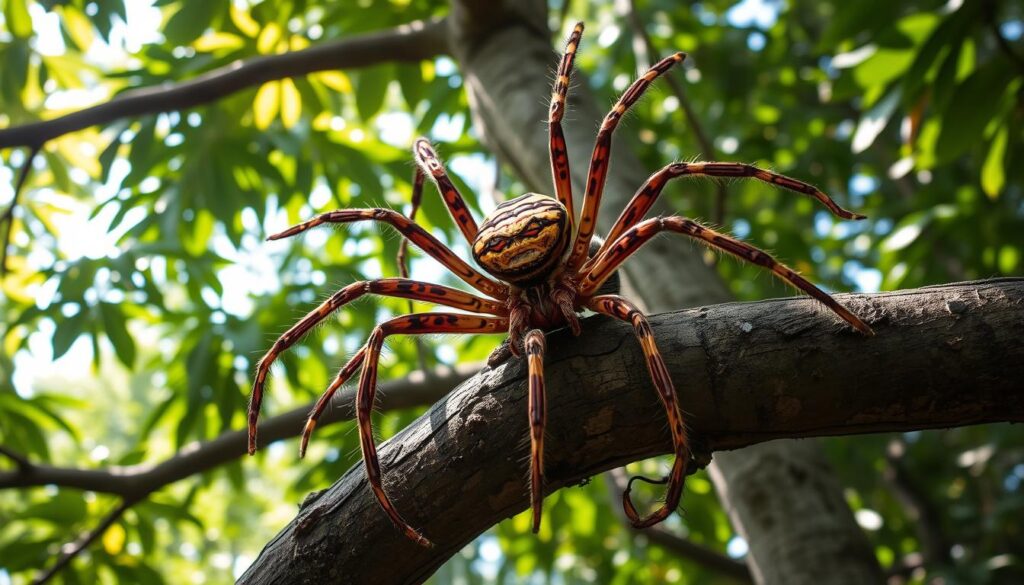
Exploring the World of the Wood Huntsman Spider
Get ready to explore the amazing world of the wood huntsman spider. These spiders are part of the Sparassidae family. They are known for their unique looks and how well they adapt to forest life.
These spiders can blend in perfectly with their surroundings. They also have incredible climbing skills. This lets them move easily through the forest’s complex paths.
Even though they are smaller than giant crab spiders, they are still very impressive. Learning about their behaviors and homes helps us understand the huntsman spider family better. They show us the amazing diversity and adaptability of these spiders.
So, let’s start an exciting journey to learn more about the wood huntsman spider. We’ll uncover the secrets and mysteries of these fascinating spiders. And we’ll see how they live in the forest’s lush ecosystems.
